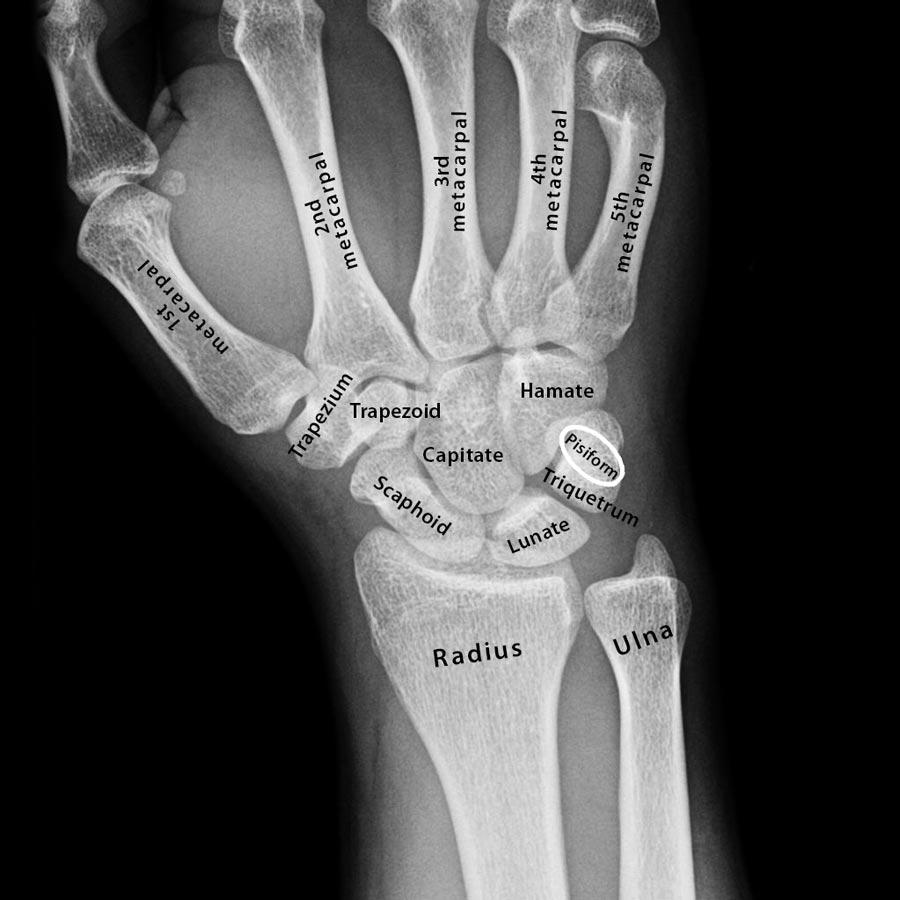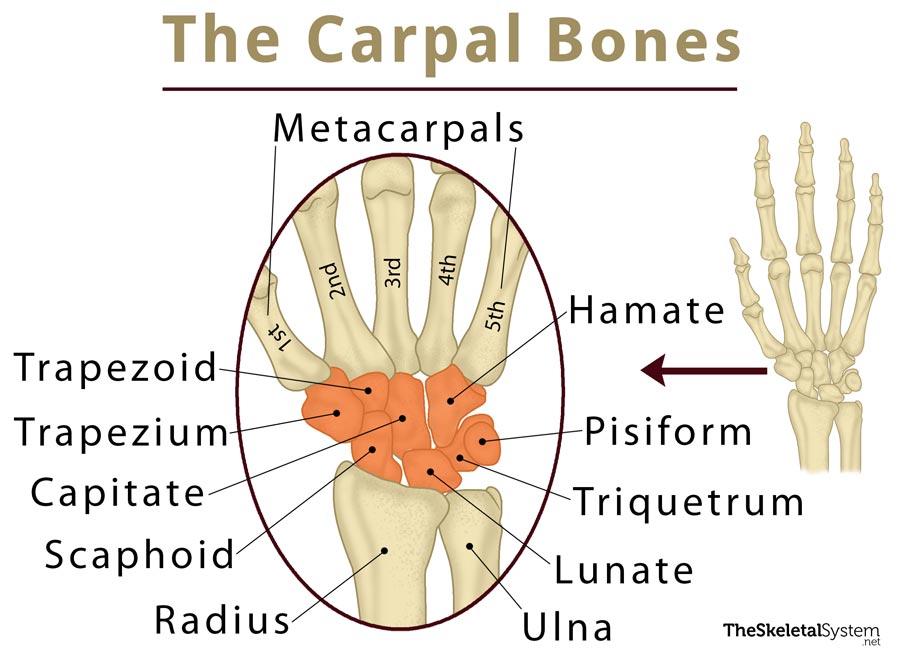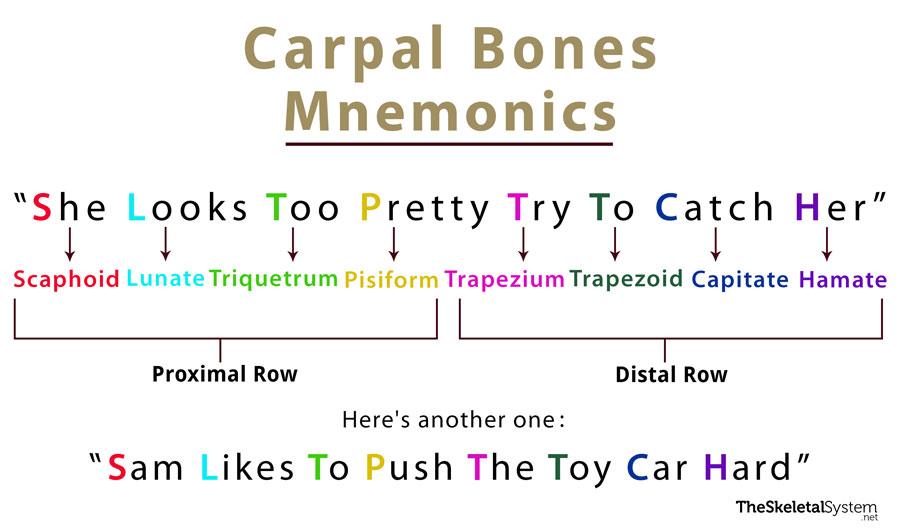Carpal Bones (Wrist Bones)
What are the Carpal Bones
The carpal bones are a group of short bones [24] in the human hand that forms the wrist along with the distal ends of the radius and ulna [1]. Hence, they are also known as wrist bones. Collectively known as the carpus, they individually articulate with the long bones in the lower arm radius and ulna and the metacarpals to make up the wrist joint.
How Many Carpal Bones are there in the Hand
There are 8 bones in the human wrist, each one being named according to its shape:
- Scaphoid (boat-shaped)
- Lunate (crescent moon-shaped)
- Triquetrum (pyramidal)
- Pisiform (pea-shaped)
- Trapezium (irregular trapezium-shaped)
- Trapezoid (wedge-shaped)
- Capitate (head-shaped)
- Hamate (wedge-shaped with a bony extension or ‘hook’)
The capitate is the largest of all carpal bones [2].
Functions
Each carpal bone is vital in forming the carpus or wrist joint, which is the key to hand movement [14], allowing us to do anything from writing, typing, and eating to holding anything in hand. The carpal bones are the connection between the forearm and hand and are the key to torque generation, which provides grip strength to humans [15].
Anatomy of the Wrist Bones
How are They Arranged
The carpal bones in the human wrist are arranged in two rows – the proximal carpal row, articulating with the lower arm bones radius and ulna, and the distal carpal row, articulating with the metacarpals.
Proximal Carpal Row(from the radial side to the ulnar side [5]) |
Distal Carpal Row(from the radial side to the ulnar side [5]) |
| Scaphoid | Trapezium |
| Lunate | Trapezoid |
| Triquetrum | Capitate |
| Pisiform | Hamate |
Understanding their Location
The radial side means on the side of the radius bone, with the easiest way of remembering this being that the radius is located on the same side as the thumb [6]. So, the scaphoid being the first bone in the proximal row means it articulates with the radius. The trapezium, the first bone in the distal row, articulates with the first metacarpal (metacarpal of the thumb), while the trapezoid (second bone in the distal row) articulates with the second metacarpal and so on [7].
Easy way to remember the carpal bones (Mnemonic)
Memorize the following sentences as they work as an acronym for the wrist bone names:
Carpal Bone Joints
All the joints involving the carpal bones are synovial joints, where the articulation surface has a flexible cartilage layer, along with a fluid lining to allow for better freedom of movement [22].
The Radiocarpal Joint: Those between the radius and the proximal carpal bones (except pisiform) [8].
Intercarpal Joints: Articulations between the carpal bones in the hand are an example of gliding joints [9] (a type of synovial joint). The bones meet and articulate on a nearly flat surface, and they need to glide past the adjacent bones in different directions during movement [10].
Carpometacarpal Joints: Those connecting the metacarpals and the distal carpal bones. The carpometacarpal joint of the thumb has a characteristic saddle shape, which makes the thumb much more flexible than the rest of the fingers [8]
The Carpal Tunnel
The carpal tunnel is a passageway for the medial nerve, as well as nine tendons passing from the wrist into the hand and fingers [11]. It is located on the palmar side of the wrist, with its boundaries formed by the carpal bones and the flexor retinaculum (a fibrous band arching over the carpal bones on the palmar side) [12].
Blood Supply
The carpal bones get their primary blood supply through the radial, ulnar, and anterior interosseous arteries, as well as the deep palmar arch [13].
Ligament Attachments
The ligaments in this area can be classified into separate groups depending on the bones involved in their attachment. The radioscaphocapitate and the long and short radiolunate ligaments joint the radius with various carpal bones. Similarly, the ulnolunate and ulnocapitate ligaments attach the ulna with the lunate and capitate bones respectively [14].
Additionally, multiple ligaments keep the carpal bones in place by attaching them with each other. These include the lunotriquetral, trapeziotrapezoid, scaphotrapezial, scaphotrapezoidal, scaphocapitate, capitotrapezoid, capitohamate, and triquetrohamate ligaments [14].
Development and Ossification
All the carpal bones are cartilaginous at birth, starting to ossify one by one within 1-2 months of age [3]. Seven of these eight bones become fully developed by the time a child is 6-7 years old, with the order of ossification being the capitate at first, followed by the hamate, triquetrum, lunate, scaphoid, trapezium, and trapezoid. The pisiform is the last to develop, ossifying fully by 12 years [4].
Common Injuries and Associated Conditions
Fracture and Dislocation: The wrist is most frequently injured among all joints in the human body [16]. Due to their position in the hand, the carpal bones often get fractured or dislocated as a result of accidents, like falling on an outstretched hand [17], and sports injuries, especially when playing sports like hockey and tennis. One characteristic symptom of a broken or dislocated carpal bone is that the pain gets worse with movement [18]. The scaphoid is the most commonly fractured carpal bone, while the most common forms of dislocations in this area involve the lunate [16].
Carpal Tunnel Syndrome: Another common condition involving the wrist, the carpal tunnel syndrome occurs when the medial nerve gets compressed in its passage through the wrist. It usually causes a characteristic pain, numbness, and tingling sensation in the fingers (may not be as prominent in the little finger) [19].
Carpal Avascular Necrosis: A condition where a lack of blood supply to the carpal bone cells causes serious damage, finally resulting in their death. The lunate and scaphoid are most prone to this degenerating disorder [20].
Other conditions that may involve the wrist include torn ligaments, arthritis, overuse injuries, and joint infections [21].
References
- https://www.mayoclinic.org/carpal-bones/img-20007898
- http://www.mananatomy.com/body-systems/skeletal-system/carpal-bones-wrist
- https://radiopaedia.org/articles/ossification-centres-of-the-wrist
- http://sketchymedicine.com/2016/01/carpal-bone-ossification/
- https://www.kenhub.com/en/library/anatomy/carpal-bones
- http://sketchymedicine.com/2015/04/describing-where-things-are-on-the-hand/
- http://teachmeanatomy.info/upper-limb/bones/bones-of-the-hand-carpals-metacarpals-and-phalanges/
- https://www.dummies.com/education/science/anatomy/joints-of-the-wrist-hand-and-fingers/
- http://www.innerbody.com/image_skel07/skel32.html
- http://www.bbc.co.uk/science/humanbody/body/factfiles/joints/gliding_joint.shtml
- http://teachmeanatomy.info/upper-limb/areas/carpal-tunnel/
- https://www.ncbi.nlm.nih.gov/pmc/articles/PMC3558235/
- http://www.wheelessonline.com/ortho/blood_supply_to_the_wrist
- https://emedicine.medscape.com/article/1899456
- https://www.kenhub.com/en/library/anatomy/the-wrist-joint
- https://patient.info/doctor/carpal-fractures-and-dislocations
- https://emedicine.medscape.com/article/97565-overview
- http://www.nsmi.org.uk/articles/wrist-injuries/fractured-carpal-bones.html
- https://orthoinfo.aaos.org/en/diseases–conditions/carpal-tunnel-syndrome/
- http://www.davidhildrethmd.com/carpal-avascular-necrosis.html
- http://baylorarlington.com/hand-and-wrist-pain/wrist-conditions/
- https://opentextbc.ca/anatomyandphysiology/chapter/9-4-synovial-joints/
- https://emedicine.medscape.com/article/1254517-overview?pa=gCCnT9WoQtvHVbIRiKc1dD%2FEuWoLmcgPcQJlQvLUG0Q9hvpv8mBToC%2B8%2BRE9%2BGgs56MI7dGTgNawPfsOtJla9Q%3D%3D




